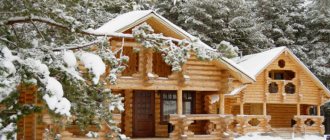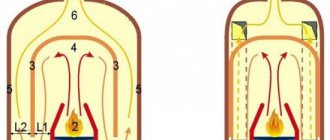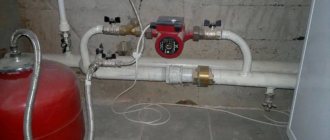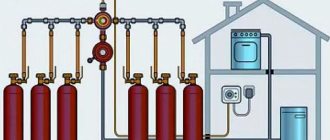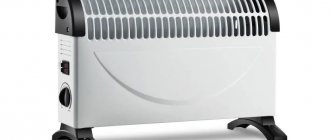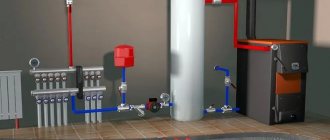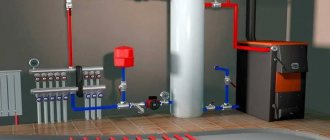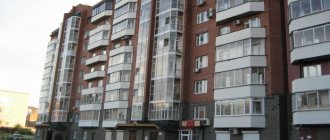There are many ways to heat your home, but air heating of your home deserves more attention. This is a reliable and high-performance system that is quite capable of providing the necessary heat to even large buildings.
The peculiarity of the air system is that the heating of the space occurs precisely through the air, which intensively circulates throughout the entire volume. This method allows you to heat the house much faster, since cold masses are intensively replaced by warm ones. There are several such heating systems.
Air heating of a private house
Air heating of a private home should be understood not as a separate device with a narrow focus, but as a complex of equipment that should be correctly called a climate system. In a simple version, it consists of the following components:
- a heat generator, which can be a gas, solid fuel or electric boiler, as well as a heat pump or solar system;
- air ducts for pumping warm masses and removing cold ones;
- systems for directing air flows and heating street air for ventilation of premises.
The essence of such heating is to heat the air passing through it with powerful thermal equipment and pump it to the heated rooms with duct-type fans. When air enters a room, it tends to rise, but as it cools, it falls down. But it does not have time to fall, because it is pulled out through the return air duct back to the boiler to reheat it.
Service: main features
To keep the number of breakdowns to a minimum during its service life, it is necessary to provide the system with timely maintenance. The frequency of the procedure depends on its complexity, intensity of use, and other factors.
It is better to trust the service to professionals Source seaside-home.ru
Air heating of a country house requires the following regular actions:
- Visual inspection of equipment, diagnostics of individual components.
- Cleaning and replacing filters , cleaning and replacing the humidifier pad, cleaning the heat exchanger.
- Automation check.
Timely maintenance will avoid power loss, equipment breakdowns, and repairs. Some work can be carried out independently, for example, replacing and cleaning the filter or cleaning the heat exchanger. Other work requires qualifications and it is better to leave them to specialized companies.
Air heating system
The basic principle of an air heating system is to circulate the bulk of the air inside the building, heating it more and more with each cycle. But this can lead to clogging of the space, so freshly cleaned from the street is periodically mixed into it. In order not to lose heat from the premises, it is heated indirectly through a plate or other type of heat exchanger. As you know, air is a good heat insulator.
It is enough to recall the design of a multi-chamber window and compare it with single glass. You shouldn’t even ask which room will be warmer, because the answer is obvious. And thanks to what - the layer of air that is in the double-glazed window. That is why air can easily become an effective coolant, and in many respects it is better than water in radiators and pipes.
The following types of air systems are distinguished depending on the type of heating device:
- Solar, in which the air is heated indirectly through a heat exchanger, they are built from many heat exchangers that are mounted on the sunny side of the house in each room.
- With gas, electric or solid fuel boiler. Has an appliance in the boiler room that heats the air passing through it to an effective temperature. It is transmitted to the premises through air ducts.
- Air-to-air, ground-to-air and water-to-air heat pumps.
Furnace-heater Miracle
Such a heating device provides high-quality heating for premises of any purpose for a long time, while little fuel is wasted.
Device
This device is an all-welded steel structure. The transfer sheet divides the combustion chamber into two compartments. The top contains nozzles and an injector. At the bottom there is smoldering fuel.
The heater is covered with a special steel casing: it reduces the heating temperature of the walls of the device and allows the heat to escape evenly. Thanks to this element, it is impossible to get burned on the stove.
Principle of operation
The process of gas generation is the smoldering of fuel with minimal access to oxygen. Re-burning of the gas occurs using special nozzles.
Such a device can be heated with firewood, garbage, dry manure, and peat. One load of fuel material provides the structure with continuous operation for 6-8 hours.
Application area
The “Miracle” stove-heater can be used for heating summer cottages, large cottages, industrial buildings, outbuildings, garages, and greenhouses.
Advantages
Such a heating device begins heating immediately after kindling. Warmth will come to the house in about 20-30 minutes. In addition, its advantages include independence from gas, oil, electricity, uniform heating of the entire room, work with any type of fuel (with the exception of coal), and high efficiency.
The Miracle oven is an economical and easy-to-use device that does not require special maintenance or care. Its combustion process can be controlled. Installation of such equipment will be inexpensive. You can cook food and heat water on it.
Types of air heating systems
There are many types of air heating systems, but first they should be divided into local and central. Accordingly, the former are used for private houses and cottages, and the latter for industrial facilities with large heated areas. Systems are also divided according to the principle of heat exchange:
- with full recirculation;
- with partial;
- direct flow
Direct-flow systems are used for heating industrial facilities. In them, warm air is supplied to rooms and halls through central channels. For a private home, it is preferable and more economical to use systems with full and partial recirculation, in which heated air penetrates into the room just above the point where the settled cold air is taken in.
They can also be distinguished by the location of the deflector through which heated air is distributed throughout the room:
- floor;
- hanging;
- built-in ceiling, wall and floor.
Comparison with water heating in terms of convenience and efficiency
The classic solution for heating rooms today in Russia is the use of water heating. However, this system, consisting of a closed chain of pipes, radiators and a boiler, filled with water or non-freezing liquid flowing through the pipes, does not suit many people, and for good reason. Low efficiency, high energy consumption and inertia of the water heating system, as well as the constant rise in energy prices, force many Russians to look for other, more modern and economical solutions when choosing ways to create a comfortable climate in their future home, and increasingly their choice is air heating .
How to warm up a house with air?
We can talk for a long time about how to warm a house with air. The essence of all air systems is one. There is some kind of powerful heating device that warms up and at the same time pumps air into the rooms through ducts with a powerful fan. As a result, this system will perform the following functions:
- heating;
- ventilation;
- air conditioning in summer.
Air conditioning is carried out by cool air, which is cooled through the boiler and passing through cooled channels. There is no need to install any additional equipment, because it solves everything. In this case, the boiler can operate at a minimum, because it will still not be possible to overheat the air, and this is not necessary.
Video description
In this video we will discuss whether it is possible to install air heating yourself:
To ensure that the procedure is successful and quick, it is recommended to order regular inspections of the system from a trusted company. Many users enter into a service contract with one company, and specialists perform work every season or at other established intervals.
A properly designed and maintained system will last a long time Source remlandia.ru
See also: Catalog of companies that specialize in designing country houses
Air source heat pump for home heating
The main task in an air heating system is to heat the air. An electric, gas and solid fuel boiler can cope with this work. Often it is impossible to supply gas, you don’t want to heat with wood, and electricity is very expensive, then an air source heat pump comes to the rescue for heating the house.
This is an innovative and very efficient equipment that uses natural resources to heat the air inside the building. This could be water, soil or ambient air.
There are several types of air source heat pumps, but the classic version is a standard split system. It consists of a heat pump and fan mounted outside and a heat exchanger located inside the building. The hot water boiler is either separate or integrated into the indoor unit. To heat water or warm the air inside a building, they take heat from the outside air or water. Any air heat pump has a high conversion efficiency, which differs by 5 times. For 1 kW of consumed electrical energy there is 5 kW of thermal energy.
Construction of gas generator furnaces
The gas generator furnace is a separate direction in the heating equipment industry. The principle of its operation is as follows: solid fuel burns with a small amount of oxygen; under the influence of low temperature values, pyrolysis gas is produced. This substance mainly consists of methane and carbon monoxide, has a high heat transfer coefficient, which helps to increase the operating efficiency of such equipment many times over. Fuel in this design burns almost completely. Heat is transferred through heat exchangers to the fluid in the system.
Gas-generating furnaces of various types are offered by many manufacturers of heating equipment. You can also make them yourself.
Air gas heating
An example of air heating of a private house is a system equipped with a gas boiler. Such solutions have been actively used in Canada for a long time. It has repeatedly proven its effectiveness and its advantages over classic water heating with heated floors. This heating consists of the following components:
- gas air boiler with integrated volute fan;
- a system of supply ducts distributed around the perimeter of the building with uniform spacing;
- a system of return air ducts through which cooled air is drawn back into the boiler for heating.
Simultaneously with heating, ventilation of the premises is carried out by mixing indoor air with outdoor air. This type of heating is highly efficient and economical. The main property of heated air is that it independently spreads throughout the space, uniformly increasing the temperature at all points.
What is combined heating
Combined (mixed) is a heating system that contains both traditional high-temperature (conventional radiators, convectors) and low-temperature (warm floors, less often warm walls) heating devices.
Water floors in a combined system are connected in two ways:
- For existing heating boilers. The advantages of this solution are a reduction in the estimated cost of equipment and a reduction in installation time. Disadvantage - additional heating cannot function in autonomous mode. This causes an increase in thermal energy consumption, and the efficiency of using heated floors decreases.
- Install hotel boilers for floor heating. The disadvantage is a significant increase in cost. Advantages: complete autonomy; water floors can be used independently of radiators. This may be necessary for a small heating of the room when the batteries are already turned off, for example, in the autumn-spring period.
1st floor - heated floor, 2nd floor - radiators
Features of air heating
Air heating of a private house has a lot of features:
- Savings on electricity because only the fan will need to be powered. For heating a house of 100 square meters. m, a 0.5 kW motor will be sufficient.
- High efficiency. A person feels comfort with his body, so it is correct to heat not the walls, but the air. All that remains is to correctly plan the location of the discharge deflectors, which can also descend from the floor and be laid under the floor. Concrete, brick and other mineral materials quickly absorb heat, partially heating the street.
- High rate of heating of rooms. Air systems use fans that quickly deliver heated air to every corner, so you can warm up rooms much faster this way.
- Possibility of quick temperature change. Due to the intense movement of air masses, you can quickly change the temperature in each room.
- Ventilation and heating in one. There is no need to additionally lay ducts for ventilation, because heating ducts can also bring fresh air, which is preheated by the boiler.
How to perform a preliminary calculation
In fact, it is very difficult to independently calculate air heating. Often only specialists can do this. The calculation determines:
- heat losses for each room in a heated house;
- type of heater and its power, which should be comparable to the amount of heat loss;
- the required amount of heated air, taking into account the heater power;
- required diameter of air channels;
- pressure loss in the air installation, etc.
The right decision would be to order an example of calculating air heating at home from specialists. It is likely that as a result, engineers will offer several options; all that remains is to choose the most acceptable one.
Heating with air is economical, safe, extremely easy to use and at the same time durable and reliable. It is not surprising that it is gaining more and more popularity. However, it is quite difficult to arrange air heating with your own hands. Possible errors can lead to unpleasant consequences in the form of drafts in rooms, noise, overheating of equipment, etc. Those who choose this practical system should seek help from professionals. A well-designed and high-quality installed system will provide warmth in your home for decades.
Air heating is actually an ancient thing. And it goes without saying that, again, Europe and America are ahead of the rest. Because it's not like that! After all, an ordinary Russian stove is also one of the options for air heating! How many villages are there in Russia where they still use this heating method? There are enough of them! And yes, I would not classify such a stove as environmentally friendly. Still, when burning fuel - whether wood or gas - it harms our planet. But air heating can be done completely without harm to nature. After all, you can use the energy of the sun! This idea is not so new anymore, and there are even people who brought it to life!
House air heating scheme
To achieve maximum heating efficiency, it is recommended to design and install air ducts during the construction of the building along with the laying of load-bearing structures, because the correct geometry of air distribution guarantees rapid heating and optimal air exchange. Accordingly, many different schemes can be applied:
- The flow principle, when heated air is pumped into one side of the room, and cooled air is taken into the other, thereby passing through the entire room.
- With full recirculation when a coaxial duct is used. Hot air is blown out through the central pipe and sucked into the external system. The heated masses manage to penetrate to the center of the premises and return back. Several such points are needed to ensure air exchange throughout the entire space.
- There are also schemes in which hot air is pumped through deflectors located around the entire perimeter of the building at regular intervals. The cooled one is concentrated in the center and taken back to the heater.
The choice of a specific scheme depends on the geometry of the premises and the stages of construction. If the entire building is already ready, then laying point connections is easier than installing a central channel around the perimeter.
Options for increasing furnace efficiency
Increased efficiency due to the air circuit
Throughout history, many tricks have been invented to increase the efficiency of the stove. One of them is the arrangement of an additional air circuit around the furnace. To do this, the furnace walls are covered with an additional layer.
For these purposes, by the way, you can use not refractory, but ordinary double silicate brick M 150. But when lining the stove, you should make a gap between the masonry sufficient for air circulation. Typically this distance is approximately 5 cm.
Furnace air circuit
For air circulation in the air space between the firebox and the outer layer, holes are provided in the upper and lower parts of the outer masonry of the brick fireplace stove. They are necessary for air circulation. They are created by loosely fitting bricks together.
They are performed starting from the second row of masonry. In this case, the instructions instruct to do them in no more than three rows, both at the top and at the bottom. There should be no holes in the upper part, or more precisely in the last two rows of masonry.
The initial process of laying a furnace
It is worth noting that when laying the outer layer, you should be careful not to accidentally cover these holes with mortar.
Due to the natural circulation of air in the gaps of the circuit, heat exchange occurs between the air and the masonry of the first layer. This almost doubles the heating area of the stove, which significantly increases its efficiency.
Increasing the efficiency of the stove due to additional chimney passages
Another fairly common way to increase the efficiency of boilers is to create additional flue passages. But this action must be performed only after careful calculation. Since an increase in the number of strokes leads to a decrease in thrust, and this circumstance can lead to the impossibility of the combustion process.
Brick heating stoves for summer cottages are usually made with no more than three gas duct strokes. This allows you to heat the room as much as possible using natural draft. A larger number of strokes may require installation of forced flue gas removal.
Air System Operation and Design Principles
If we compare the complexity of installation and the amount of work to create a water or air heating system, then the volumes will be the same, but the risks regarding property damage and harm to health are much less. There is no hot water in the radiators, as there are none either. There is no risk of antifreeze poisoning and property damage, as a leak may occur. But unlike a water system, air heating must be designed during the construction stages, since air ducts are much larger in area than water pipes. You also need to consider:
- speed of distribution of heated air in rooms;
- places where warm air is discharged in rooms and exhaust air is taken in;
- soundproofing of rooms, since the channels will also be good conductive lines for sounds.
Air heating options
So, our task is to heat the air masses and supply them to the premises of a country cottage or apartment. How to organize air heating:
- From the fireplace, wood stove.
- Use VRF systems using freon. Simply put, inverter air conditioners, air source heat pumps.
- Install a combined boiler + chiller + fan coil air conditioning system.
- Organize centralized air heating (abbreviated as VO), combined with ventilation of a private house. Use an electric heater or a gas air-heating furnace as a heat source.
A veranda with a large glass area can be conveniently heated with hot air supplied from the floor
Reference. The latter option is often implemented in American and Canadian cottages built using frame technology. The heater is a gas oven.
For heating/cooling large production workshops, a slightly different scheme is implemented. There are 2 networks of air ducts built in the premises - supply and exhaust. Both converge to a ventilation unit - a central air conditioner, consisting of the following blocks:
- 2-3-stage filters purify air masses before being supplied inside the building and emitted outside;
- heat exchanger-heater No. 1 heats the flow using hot water from the boiler room;
- heat exchanger No. 2 serves to cool the air and works in conjunction with a chiller;
- a plate cross (or rotary) recuperator removes heat from the exhaust flow and transfers it to the supply flow, saving 50...80% of energy;
- humidification unit;
- Centrifugal fans force flows through sections of the central air conditioner and further along the air ducts.
Why did we describe the design of an industrial climate control system? So that you immediately understand: installing full-fledged air heating + ventilation + cooling is not an easy and expensive task. But, as the owner of a country house, you can consider all heating methods, choose the simplest and cheapest, or return to the water scheme - heated floors, radiators.
Industrial series heating system running on natural gas
How to organize stove heating
An important advantage of any stove: it simultaneously heats the air and surrounding surfaces with intense infrared radiation. No batteries or coolant pipes are needed.
Clarification. Stoves or fireplace inserts with a water circuit can be used to heat 2-3 small rooms. The coil is connected to a gravity or closed system with a pump.
How to use a stove for pure air heating:
- For 1 room it is enough to install a cast iron or steel potbelly stove.
- To heat 2–3 rooms with a total area of up to 40 m², place a brick stove of a suitable design in the wall between the rooms.
- It is not easy to build a stove in a lived-in house. If there are no high aesthetic requirements, we install a potbelly stove, attach convection casings to the firebox and connect air ducts.
Cast iron stove with air pipes and a ceramic heat accumulator on the chimney
Option No. 3 involves laying air ducts into adjacent rooms and installing duct fans that can withstand the temperature of the moving medium 100–150 °C. Air can move through the pipes on its own, but too slowly, and the ventilation duct must slope upward. How such an air heating system works, see the video below.
The first two options are well known, but not always applicable:
- It is generally unrealistic to install a stove in an apartment;
- even a large Russian stove is not able to cover an area of more than 50 square meters (on one floor), so it is suitable for heating a dacha or a small house;
- the foundation plus a brick stove-fireplace is erected during the construction or major renovation of the building;
- a metal potbelly stove takes up space and is dangerous for small children (in terms of burns).
You can install an iron stove with your own hands - this is a tangible plus. But you will also have to heat it, which results in a lot of inconveniences: frequent loading, the smell of firewood and smoke in living rooms, dust. The author of the video acted wisely by placing the potbelly stove in a separate furnace room.
We do not recommend repeating one thing after the home craftsman - installing air ducts made of aluminum corrugations. Such pipes create high aerodynamic resistance and greatly slow down the flow. It is better to use galvanized boxes.
Preliminary conclusion. Solid fuel stoves are a budget option for air heating with their own advantages and disadvantages. Suitable for small buildings - country houses, garages, greenhouses.
Application of air conditioners and heat pumps
As you know, modern split systems are able to operate in heating mode, consuming three times less electricity than a conventional electric boiler of the same power. Hence, a completely workable solution is to buy and install an inverter air conditioner in each room.
Reference. Why an inverter? The compressor in such “splits” does not stop, and therefore does not freeze in the cold. The air conditioner successfully heats the air down to -5 °C outside, after which the efficiency noticeably decreases.
The advantages of this scheme are obvious:
- lack of batteries, pipes, boilers and other heating equipment;
- relative ease of installation;
- aesthetic appearance of the indoor unit;
- cooling mode in summer;
- Possibility of installation in apartments.
The air-conditioned heating method is viable in the southern regions, where the temperature rarely drops below -15 °C. To the north, “splits” are used only during the transition period – in spring and autumn.
Other disadvantages of heating with a split system:
- Air conditioners will have to be installed in all rooms, which is unacceptable for cottages of 2–3 floors. A multi-split VRF system will cost more than the same number of single coolers/heaters.
- The device “can” clean, dry and change the temperature of the air flow. Rare models are designed to mix in outside air. This means that you will have to do separate ventilation.
- When the external unit of the air conditioner is operating, the distinct noise of the fan and the hum of the compressor can be heard from behind the wall.
The problem of efficiency at low temperatures is solved by an “air vent” heat pump, whose performance remains intact down to -30 degrees below zero. The design and operating principle are identical to the split system, the differences being the larger size and price. If the external unit is installed on the ground and carried 2-3 m from the building, the noise of the unit will become inaudible.
Brief conclusion. VRF systems are good for apartments and small houses located in the southern regions. Heat pumps can also be installed in northern latitudes, but the cost of the equipment plays a role here. If desired, you can install the air conditioner yourself.
Combined multi-zone systems
In this case, the coolant is still used, which is why the system is called combined. How this equipment works:
- Each room has an air heating/cooling unit - a four-pipe fan coil unit that looks like an indoor air conditioner unit.
- One pair of pipes supplies the units with coolant from the boiler. Hot water passes through a heat exchanger blown by a fan, causing the room air to heat up.
- When it is necessary to switch to cooling, the automation switches the fan coil to the second pair of pipes supplying cold water from the chiller.
- Users in rooms can set different air temperatures, but they cannot turn on cooling and heating at the same time. Hence the second name of the air conditioning system – multi-zone.
Note. Chiller is a type of refrigeration machine designed to cool liquid. Usually located on the street under a canopy or in an open place (depending on the design).
Various fan coil units are used inside the building - wall-mounted, duct-mounted, floor-mounted, ceiling-mounted. It all depends on the wishes of the homeowner and aesthetic requirements. Duct-type units can be built inside ventilation ducts to heat/cool the supply air.
Connection diagram of a cassette, duct and floor fan coil to a chiller and boiler
Advantages of multi-zone air systems:
- applicable in large buildings with 20 or more rooms - administrative and residential buildings, warehouses, and so on;
- can work in conjunction with forced ventilation of the cottage;
- any heat generator is used for air heating - a boiler using solid fuel, gas, electricity, diesel fuel;
- pipes with coolant (coolant) take up little space, air units are easily built into the ceiling, hung on the wall or hidden behind the cladding;
- closed terraces with stained-glass windows covering the entire wall are heated by in-floor convectors or wall-mounted fan coil units;
- possibility of adjusting the temperature in individual rooms, remote control.
We believe that the boiler + fan coil + chiller scheme is the most universal and successful from the point of view of aesthetics and operation. Of course, you can’t do this type of air heating yourself; this is a minus. It is necessary to make calculations, select equipment, install, adjust... without knowing the basics, it is extremely difficult to carry out these works.
Let's list other negative points:
- high price of air conditioning units;
- the boiler and chiller are quite large devices, occupying 2–3 m² of area;
- the operation of the system depends entirely on electricity; when the lights are turned off, the heat supply will stop.
Conclusion. A multi-zone combined scheme is the best way to air-heat a home. But implementation will require significant investments.
Heating combined with ventilation
This is a classic method of heating buildings with air, used in enterprises since the last century. Subsequently, manufacturers began to produce small-sized analogues of industrial ventilation units installed in private homes. Thanks to less stringent requirements for air purity, the treatment scheme has also been simplified.
Let us explain the principle of operation of the “ventilation + heating” system step by step:
- The heat source is a stove, usually a gas one. A burner, an air heat exchanger, a fan and an electronic control unit are installed inside.
- The first network of ducts radiates from the furnace, distributing heated air throughout the rooms. With the help of diffusers, grilles and other supply devices, jets are supplied to the premises (usually to the upper zone).
- The second network of channels collects polluted/cooled air from the lower zone of the rooms into a common collector connected to the stove from below.
- Having passed through the collector, the exhaust air masses are cleaned in a mesh or cell filter, then sent to a heat exchanger, where they are heated by a burner.
- Electronics monitor the safe operation of the gas air heater, maintain the outlet temperature, and signal when the filters are dirty.
Typical air heating circuit with recirculation. The heater is a furnace and an air conditioner with a ducted indoor unit
Addition. Since the heater dries the air, an automatic humidifier with an electronic hygrometer is usually installed on the supply duct. The latter is located on the return air duct to measure the humidity of the flow.
The air heating stove is a rather noisy unit, so it is installed in a separate room. Combustion products are removed through a conventional or coaxial chimney (depending on the design of the heater). Air ducts made of galvanized steel are laid in several ways:
- in the basement or ground floor;
- hide in floors and wooden ceilings;
- in the attic;
- vertical channels run along the walls and are covered with facing materials.
Large ventilation ducts are laid under plasterboard finishing.
The supply air temperature reaches 40...45 °C, the speed of movement through the ventilation ducts is 4-5 m/s. You can't go any faster; there will be additional noise. In this situation, the diameter of the main collector reaches 300 mm, we took a typical flow rate of 1000 m³/h, although it can be more.
A logical question: why heat air masses to 40 °C if 22 degrees is sufficient in the house? We answer: the heating system must compensate for 2 types of heat loss - through building structures and energy consumption for heating the inflow, since ventilation is needed in any case. Accordingly, we bring the air to a temperature of 20–24 °C (compensating for losses at home), then overheat it to 40…45 °C.
Conclusion. The “ventilation + heating” scheme is the most cumbersome and expensive. The building must be prepared in advance - even at the design stage, otherwise the air ducts will go directly through the rooms. Operating efficiency is highly dependent on the way the building is ventilated, which we will discuss next.
Features of installation of an air heating system
The process of installing air heating systems in a private home has many features. They may be as follows:
- Air duct selection. It is important to understand that constant changes in temperature cause materials to expand, so seals at the joints between parts must also be able to expand.
- Select a blower fan. It can be calculated based on the volume of all rooms, selecting one that can pump all the contained air through it in the shortest possible time interval. At the same time, so that the boiler has time to warm it up to the set temperature.
- Consider ways to lay air ducts so that the air masses in them do not cool down before they penetrate inside the premises.
Installation nuances
Even if the project is completed in full compliance with GOST requirements and developed by professionals, it is not advisable to install the system yourself, since this is a very difficult process. However, you should know its features in any case:
- The cross-section of the air ducts can be round, rectangular or square; the choice depends on the characteristics of the room and the project itself.
- Air ducts are most often made of galvanized steel sheet : it is lightweight, does not deform and is not afraid of corrosion.
- Fastening of air ducts is possible inside walls, in ceilings, under the ceiling . If necessary, they are masked with decorative panels: this allows you to create an attractive room design without fear that communications elements will spoil the interior.
The components of the air heating system do not spoil the interior Source indivi-dom.ru
Note! During the circulation of air flows, the system produces noise, and to reduce it, installation of a soundproofing layer will be required. The materials used for this often serve as a heat insulator.
When installing a system with forced circulation, the device is connected to a heat source and an electrical network; you can also use an emergency power source in case of a sudden power outage.
It is also important to choose filters for heating: they can be mechanical, electrostatic and carbon. The first type is used to retain dust particles and dirt, the second is used for finer cleaning, and the third is used to eliminate unpleasant odors. These elements most often require replacement; they usually need to be changed every 2-3 seasons if the building is used for temporary residence, or at least once every six months for permanent use.
Operating principle
The operation scheme of automobile heating equipment running on gasoline or diesel fuel is extremely simple. The device sucks in cold air from one side and blows out heated air from the outlet pipe located at the opposite end of the housing. Due to the constant circulation of air masses, the room is heated.
The equipment can be part of the vehicle’s on-board system (fuel is supplied from the vehicle’s tank), or it can also function completely autonomously (in this case, you will need an individual tank with gasoline or diesel fuel).
Control can also be done either from the vehicle’s dashboard or separately.
The advantages of using an air heater to heat the interior or body of a car are undeniable:
- increases the air temperature an order of magnitude faster than a standard built-in stove;
- contributes to significant resource savings, as it consumes from 0.1 to 0.5 liters of fuel per hour;
- absolutely safe to use, emits less harmful substances into the atmosphere.
Note! The efficiency of using the described systems is so high that many vehicle manufacturers integrate autonomous climate control equipment into the manufacture of cars. An example is the Webasto air heater, which can significantly reduce the amount of harmful emissions into the atmosphere and increase the efficiency of operating trucks.
The operating procedure of an autonomous heater does not depend on the brand and manufacturer of the equipment.
The work proceeds according to the following scheme:
- receipt of a signal to start work from the operator (driver);
- checking the performance of systems and mechanisms;
- turning on the fan to supply air to the combustion chamber;
- turning on the fuel pump that supplies fuel there;
- ignition of the mixture, which will heat the pumped air;
- turning on a fan that takes in cold air and pumps it through the heating chamber.
Once the desired room temperature is reached, the heater switches to maintenance mode, which requires less fuel and electricity to operate.
Conclusions and useful video on the topic
A working heating system based on a stove and a water circuit in a private house with an area of 80 square meters:
Heat is supplied to the heating system from stoves and fireplaces in portions, which complicates the task of calculating the parameters of the heating circuit elements. Carrying out work on altering the circuit is quite problematic, so if you lack experience in this area, it is better to turn to specialists who have the skills to solve such problems.
Do you have experience in organizing stove heating? Or do you heat your home this way and would like to share your impressions of using the stove? Please leave comments and ask questions. The feedback form is located below.

